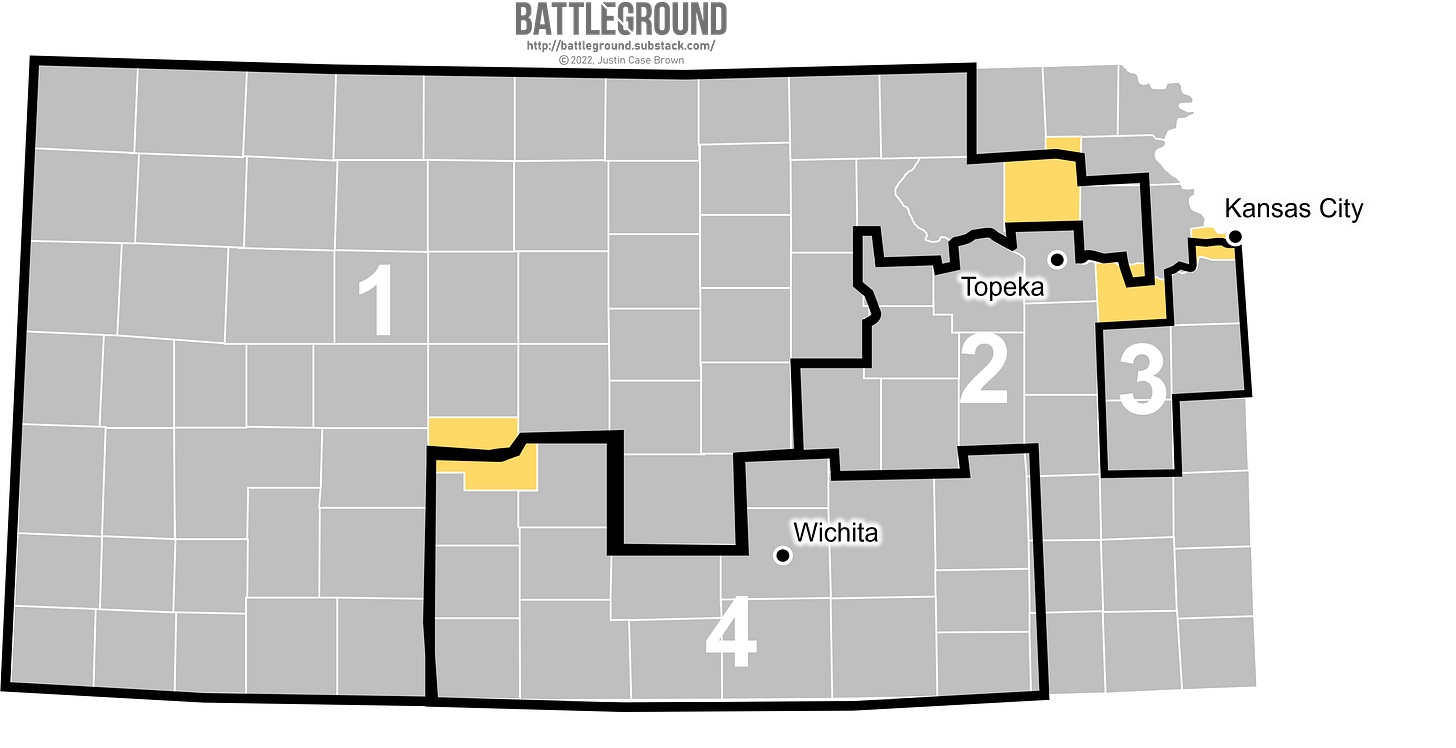Kansas: Cracking KCK
The Republican-approved map faces several lawsuits alleging a partisan gerrymander.
Topline Takeaways
Republicans drew the maps above and were able to enact them by overriding a gubernatorial veto from Democratic Governor Laura Kelly.
The new districts “crack” the state’s two most heavily Democratic counties, giving Republicans an edge in several districts across the state.
Several partisan gerrymandering lawsuits have piled up in state courts.
UPDATE: On April 25, a county judge struck down the new congressional districts for unfairly diluting the votes of both Democrats and nonwhite voters. The Kansas Supreme Court later overturned this decision, reinstating the map above into law.
Who’s In Control?
Kansas is one of only three states with a Democratic governor and Republican majorities in both state houses (the other two are Pennsylvania and Wisconsin.) The legislature controls the redistricting process and the governor holds veto power. Republicans drew the congressional map shown above in early February, garnering an expected gubernatorial veto from Gov. Laura Kelly. Republicans were just barely able to override the veto through a super-majority vote.
District Breakdown
Previously, Kansas City and its suburbs were entirely encompassed in KS-3. The neighboring KS-2 held nearly all other counties in eastern Kansas stretching as far as west as Topeka. KS-1 and KS-4 then split the remaining rural counties with KS-4 being anchored around Wichita.
The new districts are a major departure from the state’s old congressional districts, primarily due to the way it splits several counties across the state. Most importantly, the new plan splits heavily Democratic Kansas City across two districts for the first time since the 1980s. The move is largely unnecessary and many see it as evidence of a partisan gerrymander.
The ideal district size in Kansas is 734,470. The two principal counties of Kansas City, KS are Wyandotte and Johnson; together they hold 779,108 residents. Drawing a district around both counties is possible by excluding only 40,000 residents. Instead, Republicans excluded 112,000 residents from one of the most Democratic parts of the district and forced them into a new KS-2 that’s much more maze-like than its predecessor. They then chose to include three counties lying to the south of Kansas City to makeup the difference in KS-3, all areas that are much more supportive of Republicans.
This move is a clear effort to “crack” the Democratic voting coalition in Kansas City: to turn KS-3 into a district where Republicans have a better shot at electing one of their own. Overlaying the 2020 election results onto new congressional districts (map shown below) shows that two of the four split counties are currently the most Democratic in the state. This shifts KS-3 from leaning 10 points in favor of Biden to barely a 4-point advantage for the Democratic party, putting Democratic incumbent Rep. Sharice Davis on thin ice this election season. Meanwhile the other three districts remain safely Republican seats, supporting Trump in the 2020 election by a margin of 15 points or more.

-Christopher Warshaw, associate professor of political science at ‘GWU
Several lawsuits have emerged regarding the state’s new congressional districts, all alleging a partisan gerrymander. Data-driven approaches to redistricting underline how implausible it is to believe that the new districts were created without a bias toward Republicans. Jowei Chen, a political researcher from University of Michigan, had a computer draw 1,000 possible district maps using the same non-partisan guidelines that legislators should have used. The result: “99% of computer simulations Chen ran using non-partisan, traditional redistricting criteria created fewer Republican-leaning districts than the map passed by lawmakers.” Meanwhile, Republicans are fighting against these lawsuits by leaning on an emerging political theory of legislative supremacy: a belief that courts have no jurisdiction over gerrymandering cases as the U.S. Constitution states that election related matters “shall be prescribed in each State by the Legislature thereof.”
I hope you recognize how fundamentally un-American the above theory is: Republicans are pushing for unchecked legislative power that can’t be reigned in by other branches. Any high school student can tell you that the separation of powers was one of the most basic founding principles in the creation of our nation. Pushing this theory dismantles the framework that the founders used to organize American government. For a party that likes to cast itself as patriots who stand up for the Constitution and the history of this country, they’re awfully quick to dismantle those same structures to retain power.
UPDATE: The Kansas Supreme Court upheld the above map, stating that the evidence provided is not sufficient to prove the new districts’ unconstitutionality. The problem for map challengers lies in the fact that the Kansas Constitution does not hold explicit requirements for redistricting. (Many state constitutions explicitly require mapmakers to keep counties whole or to draw compact. Since the Kansas Constitution does not explicitly specify such requirements for redistricting, the existence of counties split across districts is not considered strong enough evidence of partisan gerrymandering.)





